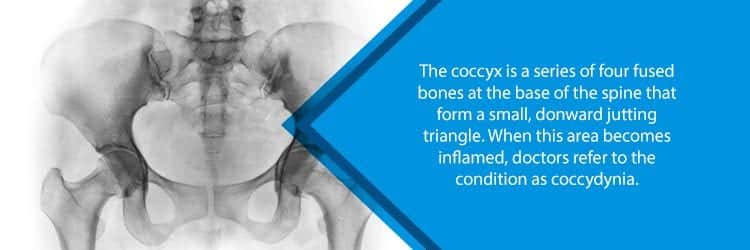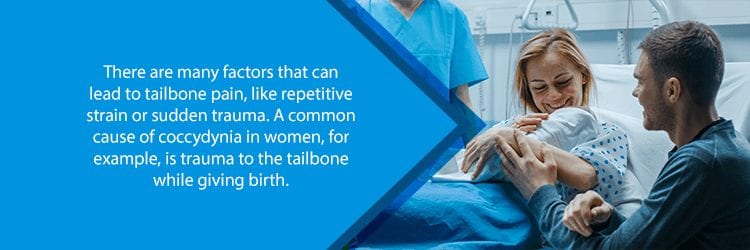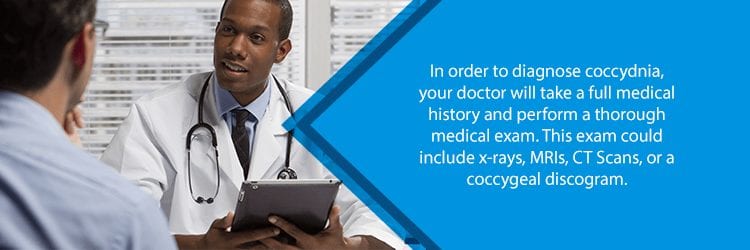Are you suffering from pain or tenderness at the bottom of your spine? Tailbone pain, otherwise known as coccydynia, can make everyday activities painful and difficult. Luckily, you have options, including minimally invasive coccygectomy from NJ Spine and Orthopedic, to help reduce the pain and get you back to doing the things you love.
Understanding the Tailbone
At the base of the spine is a triangular series of bones known as the coccyx. The sacrococcygeal joint connects the coccyx with the sacrum—another triangular structure that helps to support the weight of the upper body. The coccyx is composed of three to five bones connected by small joints and ligaments.
Early humans used to have tails supported by the coccyx. Of course, over many generations of evolution, humans no longer have tails. Even without tails, the coccyx stills serves a purpose. It connects many of the pelvic floor muscles to other areas of the body. These muscles help out with leg movement and support the anus and vagina. In addition, the coccyx distributes weight when a person is seated.

Causes of Tailbone Pain
Tailbone pain is usually a result of an anatomical condition in the coccyx. Too much movement, known as hypermobility, can put stress on the coccyx or the joint connecting it to the sacrum. Conversely, limited mobility of the area may cause the coccyx to put extra pressure on the sacrococcygeal joint.
These anatomical conditions can result from several factors. Common causes of tailbone pain include:
- Trauma to the Tailbone: Usually, falls or other injuries result in tailbone pain. Trauma may cause inflammation to ligaments that support the coccyx. Some injuries may even bruise or fracture the tailbone. Prolonged sitting or using a narrow surface on which to sit, like a bicycle seat, can also irritate the coccyx.
- Childbirth: As any mother will agree, childbirth is hard on the body. As the baby passes through the birth canal, it can put manual strain on the coccyx leading to bone, disc, or ligament injuries.
- Spine Cancer: Tumors on or around the spine may also apply strain to the coccyx.
- Obesity: Carrying extra weight in the midsection puts stress on several areas of the body including the tailbone. This type of weight distribution reduces the movement of the pelvis leading to more stress on the coccyx.
- Osteomyelitis: Some viral or bacterial infections elsewhere in the body can reach the spine through the blood or when nearby soft tissues are infected. Adults can develop osteomyelitis (or a bone infection) in any part of the spine, including the coccyx.
- Bursitis: When tiny, fluid-filled sacs that help to cushion the joints become inflamed—a condition known as bursitis—it may result in tailbone pain.

Symptoms of Coccydynia
The telltale sign of coccydynia is tailbone pain felt at the bottom of the spine near the buttocks. It may feel like an aching or soreness that ranges from mild to severe. In some cases, the discomfort radiates to the pelvic floor muscles causing tightness and discomfort.
Other symptoms include:
- More pain when sitting. Sitting or leaning backward puts more weight on the tailbone, leading to flare-ups of pain.
- Difficulty sitting or standing. When pelvic bones rotate to facilitate sitting or standing, pain may become more intense.
- Discomfort during bowel movements or sex. Since the coccyx is so close to the anus and genitals, these activities can become painful.
In some cases, tailbone pain goes away on its own or with a conservative treatment. Other patients may experience chronic pain that lasts for several months. If your pain isn’t going away or keeps returning, then it may be time to see a coccygectomy specialist or tailbone doctor.
Diagnosing Your Tailbone Pain
If you’re dealing with nagging pain from a sore tailbone, you should consult with a doctor or a coccygectomy specialist to obtain an accurate diagnosis. By learning the cause of your discomfort, your doctor can determine the most appropriate treatments.
Your doctor will review your medical history and discuss your symptoms. This discussion should include a description of your current symptoms, when they started, and what activities seem to make them worse. In addition, your doctor will ask about any work or lifestyle habits that may put added stress on the coccyx, like mountain-biking or desk work.
Your back pain doctor will also conduct a thorough physical exam. During the exam, your doctor checks for any tenderness in the area and determines if there is any swelling. In addition, a physical exam can detect any tumors or bone spurs on the coccyx.
While not always necessary, your doctor may order diagnostic imaging tests to take a closer look at the area. These tests can include an X-ray, MRI, or CT scan depending on your symptoms. Your physician may also perform a coccygeal discogram. This procedure uses an injection of a local anesthesia to identify the exact region where you’re experiencing pain.

Treatment Options for Your Tailbone Pain
In many cases, a conservative treatment can help to reduce pain in the tailbone. Some of these treatments can be completed at home without medications. For example, using ice packs or heating pads may reduce inflammation and muscle tension in the region. Using a special seat cushion can also allow you to take pressure off the area.
Doctors may suggest modifications to your daily activities to reduce strain on the coccyx. For example, if you have a desk job that requires long periods of sitting, your doctor may suggest creating a work area where you can alternate between sitting and standing. If your tailbone pain is caused by repetitive movements or sports activities, consulting with a physical therapist can provide insights into protecting your coccyx. In addition, you can learn stretches to reduce muscle tension and pain. A physical therapist or chiropractor may also perform manual manipulations to adjust the sacrococcygeal joint, thus allowing for more coccyx mobility.
Over-the-counter medications like non-steroidal anti-inflammatory drugs (NSAIDs) can reduce inflammation in the area. If bowel movements are contributing to your tailbone pain, your doctor may also suggest stool softeners or fiber supplements.
Some people have found sufficient pain relief with a Transcutaneous Electrical Nerve Stimulator, or TENS device. This unit uses electrodes applied on the skin near the coccyx region. The electrical pulses disrupt pain signals from your coccyx to the brain. These units are available online or at local drug stores. Since there are different types of TENS units, consult with your doctor about which option may be best for your condition.

Achieving Pain Relief Beyond Conservative Treatments
In many cases, the right combination of conservative treatments will alleviate your tailbone pain. In more severe cases, however, a coccygectomy specialist can suggest additional treatment options.
One such treatment option is a steroid injection. Using imaging guidance, your doctor will inject a numbing agent as well as a steroid into the affected area. This reduces inflammation in the target region, resulting in pain relief that can last from a week to several years.
Those who suffer from chronic tailbone pain may finally get relief with minimally invasive spine surgery. Those with anatomical changes or excessive mobility of the coccyx are good candidates for a coccygectomy. During this procedure, your coccygectomy specialist will perform a tailbone resection (or removal).
This procedure begins when your physician makes a small incision just above the coccyx. Then the periosteum (protective cartilage over the bone) is dissected. This allows your surgeon to remove either all or part of the coccyx.
The procedure is short—usually under an hour. The recovery time, however, can take a couple months to a year before tailbone symptoms fully disappear. However, when symptoms do fade, their disappearance can be permanent.
Seeking Help for Your Tailbone Pain
If you are ready to take the next step in treating your tailbone pain, then NJ Spine & Orthopedic is ready to help. Our dedicated team will listen to your story and learn your goals for treatment. Dr. Scott Katzman, a leading coccygectomy specialist and award-winning doctor, will review the best treatment options for you and discuss both conservative and minimally invasive relief methods.
If a coccygectomy is recommended, then Dr. Scott Katzman is regarded as a top international choice for this surgery. That’s because NJ Spine & Orthopedic has earned a 99% success rate at helping our patients eliminate tailbone pain.

